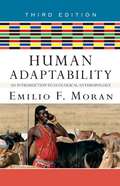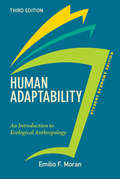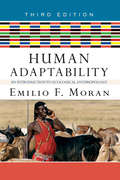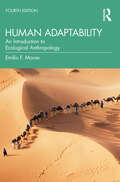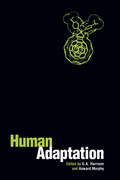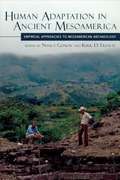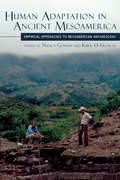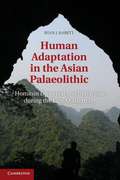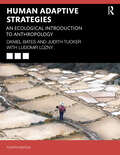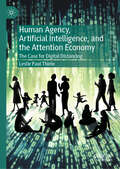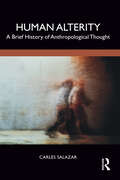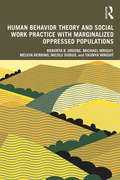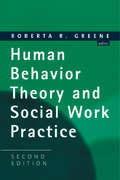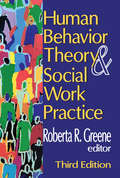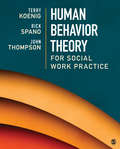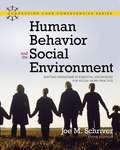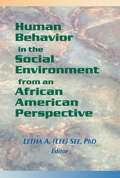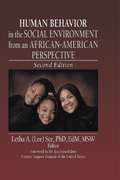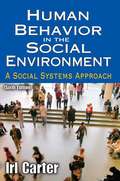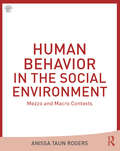- Table View
- List View
Human Adaptability
by Emilio F. MoranMoran (anthropology, Indiana U. ) provides a wealth of examples as he explains how people work in ecosystems. He begins by explaining theories of human-habitat interaction and introduces cultural ecological methods and notions about the human factor in environmental change and spatial analysis. He examines evidence of human adaptation from the arctic to high altitudes, arid lands, grasslands and the humid tropics, then thoroughly explores life in an urban ecology. The maps, photos and graphics are well-chosen and informative, and Moran has provided new chapters in urban sustainability and methods of spatial analysis, new sections giving websites, and increased attention to global environmental changes and the role of gender in human adaptability research for this edition. Annotation ©2008 Book News, Inc. , Portland, OR (booknews. com)
Human Adaptability
by Emilio F. MoranDesigned to help students understand the multiple levels at which human populations respond to their surroundings, this essential text offers the most complete discussion of environmental, physiological, behavioral, and cultural adaptive strategies available. Among the unique features that make Human Adaptability outstanding as both a textbook for students and a reference book for professionals are a complete discussion of the development of ecological anthropology and relevant research methods; the use of an ecosystem approach with emphasis on arctic, high altitude, arid land, grassland, and tropical rain forest environments; an extensive bibliography on ecological anthropology; and a comprehensive glossary of technical terms. Entirely new to the third edition are chapters on urban sustainability and methods of spatial analysis, with enhanced emphasis throughout on the role of gender in human-adaptability research and on global environmental issues as they affect particular ecosystems. In addition, brand-new sections in each chapter guide students to websites that provide access to relevant material, complement the text's coverage of biomes, and suggest ways to become active in environmental issues.
Human Adaptability
by Emilio F. MoranDesigned to help students understand the multiple levels at which human populations respond to their surroundings, this essential text offers the most complete discussion of environmental, physiological, behavioral, and cultural adaptive strategies available. Among the unique features that make Human Adaptability outstanding as both a textbook for students and a reference book for professionals are a complete discussion of the development of ecological anthropology and relevant research methods; the use of an ecosystem approach with emphasis on arctic, high altitude, arid land, grassland, tropical rain forest, and urban environments; an extensive and updated bibliography on ecological anthropology; and a comprehensive glossary of technical terms. Entirely new to the third edition are chapters on urban sustainability and methods of spatial analysis, with enhanced emphasis throughout on the role of gender in human-adaptability research and on global environmental change as it affects particular ecosystems. In addition, new sections in each chapter guide students to websites that provide access to relevant material, complement the text’s coverage of biomes, and suggest ways to become active in environmental issues.
Human Adaptability, Student Economy Edition: An Introduction to Ecological Anthropology
by Emilio MoranDesigned to help students understand the multiple levels at which human populations respond to their surroundings, this essential text offers the most complete discussion of environmental, physiologic.
Human Adaptability: An Introduction to Ecological Anthropology
by Emilio F. MoranDesigned to help students understand the multiple levels at which human populations respond to their surroundings, this essential text offers the most complete discussion of environmental, physiological, behavioral, and cultural adaptive strategies available. Among the unique features that make Human Adaptability outstanding as both a textbook for students and a reference book for professionals are a complete discussion of the development of ecological anthropology and relevant research methods; the use of an ecosystem approach with emphasis on arctic, high altitude, arid land, grassland, tropical rain forest, and urban environments; an extensive and updated bibliography on ecological anthropology; and a comprehensive glossary of technical terms. Entirely new to the third edition are chapters on urban sustainability and methods of spatial analysis, with enhanced emphasis throughout on the role of gender in human-adaptability research and on global environmental change as it affects particular ecosystems. In addition, new sections in each chapter guide students to websites that provide access to relevant material, complement the text's coverage of biomes, and suggest ways to become active in environmental issues.
Human Adaptability: An Introduction to Ecological Anthropology
by Emilio F. MoranDesigned to help students understand the multiple levels at which human populations respond to their surroundings, this essential text offers the most complete discussion of environmental, physiological, behavioral, and cultural adaptive strategies available. Among the unique features that make Human Adaptability outstanding as both a textbook for students and a reference book for professionals are a complete discussion of the development of ecological anthropology and relevant research methods; the use of an ecosystem approach with emphasis on arctic, high altitude, arid land, grassland, tropical rain forest, and urban environments; an extensive and updated bibliography on ecological anthropology; and a comprehensive glossary of technical terms. - There is enhanced emphasis throughout on the role of gender in human adaptability research and on global environmental change as it affects particular ecosystems. - Students are guided to websites that provide access to relevant material, complement the text's coverage of biomes, and suggest ways to become active in environmental issues. - The fourth edition includes updated material on climate change and environmental policy. This book is essential reading for students undertaking courses in environmental anthropology and human ecology.
Human Adaptation
by G. A. HarrisonThis book examines the concept of adaptation in four major fields in the human sciences. Genetic aspects are first considered through an examination of the human genes which have so far been identified as conferring survival value in particular environmental circumstances. The drift versus selection argument is also fully reviewed. The second contribution concerns the physiological changes which occur when individuals move from one environment to another. In the past, most attention has been given to the mechanisms of these changes, but here the focus is on the effects. The third contribution is directed at the analysis of behaviour - especially social behaviour. The application of kin selection and reciprocal attraction theories to humans is explored and the value of these approaches explained, whether the behaviour has a genetic basis or not. The final essay deals with the relevance of the adaptation concept to the social sciences and especially to social anthropology. It demonstrates that an ecological approach to understanding the nature and structure of human societies demands attention to adaptation.Reprinted in paperback for the first time and with a new foreword, this book, which serves as an excellent teaching text, clearly shows how attempts at integration in each of these various fields can benefit the study of human evolution, social structure and organization from all perspectives.
Human Adaptation in Ancient Mesoamerica
by Nancy Gonlin Kirk D. French"This volume explores the dynamics of human adaptation to social, political, ideological, economic, and environmental factors in Mesoamerica and includes a wide array of topics, such as the hydrological engineering behind Teotihuacan's layout, the complexities of agriculture and sustainability in the Maya lowlands, and the nuanced history of abandonment among different lineages and households in Maya centers.The authors aptly demonstrate how culture is the mechanism that allows people to adapt to a changing world, and they address how ecological factors, particularly land and water, intersect with nonmaterial and material manifestations of cultural complexity. Contributors further illustrate the continuing utility of the cultural ecological perspective in framing research on adaptations of ancient civilizations.This book celebrates the work of Dr. David Webster, an influential Penn State archaeologist and anthropologist of the Maya region, and highlights human adaptation in Mesoamerica through the scientific lenses of anthropological archaeology and cultural ecology."
Human Adaptation in Ancient Mesoamerica: Empirical Approaches to Mesoamerican Archaeology
by Nancy Gonlin and Kirk D. FrenchThis volume explores the dynamics of human adaptation to social, political, ideological, economic, and environmental factors in Mesoamerica and includes a wide array of topics, such as the hydrological engineering behind Teotihuacan’s layout, the complexities of agriculture and sustainability in the Maya lowlands, and the nuanced history of abandonment among different lineages and households in Maya centers. The authors aptly demonstrate how culture is the mechanism that allows people to adapt to a changing world, and they address how ecological factors, particularly land and water, intersect with nonmaterial and material manifestations of cultural complexity. Contributors further illustrate the continuing utility of the cultural ecological perspective in framing research on adaptations of ancient civilizations. This book celebrates the work of Dr. David Webster, an influential Penn State archaeologist and anthropologist of the Maya region, and highlights human adaptation in Mesoamerica through the scientific lenses of anthropological archaeology and cultural ecology. Contributors include Elliot M. Abrams, Christopher J. Duffy, Susan Toby Evans, Kirk D. French, AnnCorinne Freter, Nancy Gonlin, George R. Milner, Zachary Nelson, Deborah L. Nichols, David M. Reed, Don S. Rice, Prudence M. Rice, Rebecca Storey, Kirk Damon Straight, David Webster, Stephen L. Whittington, Randolph J. Widmer, John D. Wingard, and W. Scott Zeleznik.
Human Adaptation in the Asian Palaeolithic
by Ryan J. RabettThis book examines the first human colonization of Asia and particularly the tropical environments of Southeast Asia during the Upper Pleistocene. In studying the unique character of the Asian archaeological record, it reassesses long-accepted propositions about the development of human 'modernity. ' Ryan J. Rabett reveals an evolutionary relationship between colonization, the challenges encountered during this process - especially in relation to climatic and environmental change - and the forms of behaviour that emerged. This book argues that human modernity is not something achieved in the remote past in one part of the world, but rather is a diverse, flexible, responsive, and ongoing process of adaptation.
Human Adaptation: The Biosocial Background
by Yehudi A. CohenUnderlying the anthropological study of humans is the principle that there is a reality to which a human must adapt for survival. Populations must adapt to the realities of the physical world and maintain a proper fit between their biological makeup and the pressures of the various niches of the world. Social groups must develop adaptive mechanisms in the organization of their social relations if there is to be order, regularity, and predictability in patterns of cooperation and competition. This book presents an introduction to anthropology that is unified and made systematic by its focus on adaptations that have accompanied the evolution of humans, from non-human primates to inhabitants of vast urban areas in modern industrial societies.Human Adaptation contains over forty outstanding essays that are intended to serve as an introduction to physical anthropology, archeology, and linguistics from the point of view of the processes of adaptation. The organization of these selections contains a balance between biological and prehistoric cultural adaptations. They provide coherence for the study of human evolution. Several selections, notably those in connection with linguistic adaptations, deal with contemporary people in order to shed light on earlier evolutionary processes. More than half of the selections deal with biological evolution.This volume unifies the subject matter of anthropology within a single and powerful explanatory framework and incorporates the work of the most renowned anthropological experts on man.
Human Adaptive Strategies: An Ecological Introduction to Anthropology
by Judith Tucker Daniel Bates Ludomir LoznyThis book introduces students to cultural anthropology with an emphasis on environmental and evolutionary approaches, focusing on how humans adapt to their environment and how the environment shapes culture. It shows how cultures evolve within the context of people’s strategies for surviving and thriving in their environments.This approach is widely used among scholars as a cross-disciplinary tool that rewards students with valuable insights into contemporary developments. Drawing on anthropological case studies, the authors address immediate human concerns such as the costs and consequences of human energy requirements, environmental change and degradation, population pressure, social and economic equity, and planned and unplanned change. Impacts of increasingly rapid climatic change on equitable access to resources and issues of human rights are discussed throughout. Towards the end of the book the student is drawn into a challenging thought experiment addressing the possible impacts of climatic warming on Middle America in the year 2040. All chapters conclude with "Summary," "Key Terms," and "Suggested Readings." This book is an ideal text for students of introductory anthropology and archaeology, environmental studies, world history, and human and cultural ecology courses.
Human Agency, Artificial Intelligence, and the Attention Economy: The Case for Digital Distancing
by Leslie Paul ThielePeople relish novelty, enjoy convenience, and are prone to distraction. These natural tendencies are now being dangerously exploited in the digital world. So we find ourselves bewitched by the shimmering screens of our digital devices, like moths circling a flame. It may only be a matter of time before our downward spiral reaches a deadly nadir. Leslie Paul Thiele incisively explores the psychological, social, and political impacts of social media, artificial intelligence, and digital platforms that are designed to capture our attention and maximize engagement. Digital technologies offer countless benefits. But in the attention economy, they also heighten distraction and dependence, erode cognitive and social skills, proliferate misinformation, amplify political polarization, increase social isolation, and leave us despondent. Governmental regulation is needed, but it cannot replace the individual’s responsibility to exercise self-governance. Thoroughly grounded in the latest scientific research but accessible to the general reader, this book explains how we can cultivate the dispositions, habits, and skills needed to sustain human agency and strengthen democratic prospects. In an age of incessant technological upgrading, Thiele demonstrates a vital and practical means to avert human downgrading.
Human Alterity: A Brief History of Anthropological Thought
by Carles SalazarHuman Alterity: A Brief History of Anthropological Thought offers an introduction to the history of anthropological thought, encompassing eleven concise chapters that revolve around the concept of human alterity.Ever since the birth of our species, humans have wanted to understand people other than themselves. But what is an ‘alter’ human? Alter humans do not exist irrespective of the very concept of alterity that defines them as such. Readers find a history of what has made humanity opaque to itself: a history of the theories about human alterity produced by some humans. Chapters delve into various topics, including the discovery of America and the initial systematic theories regarding human alterity, the influences of rationalism and the Enlightenment, the impact of Romanticism, the trajectory of Social Evolutionism, the realm of Historicism, the tenets of Functionalism, explorations into the Culture and Personality school, examinations of Structuralism, analyses of political ideologies (such as Marxism, feminism, postcolonial studies, and postmodernism), and an exploration of current trends in cross-cultural studies.Human Alterity: A Brief History of Anthropological Thought will be of value to both new and advanced students of anthropology, sociology, cultural studies, social history, post-colonial studies and to anyone concerned with the belief, fantasy and reality of human diversity.
Human Behavior Theory and Social Work Practice with Marginalized Oppressed Populations
by Michael Wright Roberta R. Greene Melvin Herring Nicole Dubus Taunya WrightHuman Behavior Theory and Social Work Practice with Marginalized Oppressed Populations addresses what social workers can do to combat the increasingly complex social concerns that face the profession, and explores how to incorporate the celebration of diversity and the protection of human rights into social work curricula and the helping process. The authors combine human behavior theories with a narrative, postmodern practice methodology that deals with both the client’s or constituencies’ presenting problem and equity issues, and, as a result, the book is both theoretical and applied. Two major integrating themes throughout are at the forefront of the book—the celebration of diversity and the equality of human rights. The goal is to strengthen diversity and human rights components of the social work curriculum and to provide more practice guidelines for cross-cultural practice.
Human Behavior Theory and Social Work Practice: Human Behavior Theory And Social Work Practice (Modern Applications Of Social Work Ser.)
by Roberta GreeneThis new edition of Human Behavior Theory and Social Work Practice provides a broadly synthetic approach to selecting theoretical concepts crucial to one's activities in casework. Centered on the notion of the client as an individual, Roberta Greene and the contributing authors examine the biological, psychological, and social aspects of development, and evaluate their utility for social work practice.Social work is characterized by a dynamic helping process and a diversity of roles, and functions. The aims of social work--to improve societal conditions for individuals, families, and groups--are put into action across all fields of practice and realized through a variety of methods in a range of settings. To work in the field, it is important to acquire conceptual frameworks that help one understand the complexities of contemporary practice. This volume is concerned with the application of knowledge about behavior in the social environment that serves as the theoretical underpinning for direct practice in social work. The chapters explore the ways in which specific theories have contributed to understanding the person in the environment construct and examine the idea that all clinical social work intervention is anchored in reshaping the context of the person in the environment configuration.The book explores the challenges and limitations of the various theories in use and addresses many relevant questions: What does the theory offer for understanding development across the lifecycle? What does each theory suggest about the interaction among biological, psychological, and sociocultural factors of human development and functioning? What does the theory suggest about healthy/functional and unhealthy/dysfunctional behaviors or wellness? Is theory universal in its application, and may it lend itself to cross-cultural social work practice? What role does theory propose for the social worker as an agent of change? Human Behavior Theory and Social Work Practice is an original contribution to social work theory, and will be mandatory reading for anyone pursuing a career in the field.
Human Behavior Theory and Social Work Practice: Human Behavior Theory And Social Work Practice (Modern Applications Of Social Work Ser.)
by Roberta R. GreeneHuman Behavior Theory and Social Work Practice remains a foundation work for those interested in the practice and teaching of social work. Roberta Greene covers theoretical areas and individual theorists including classical psychoanalytic thought, Eriksonian theory, Carl Rogers, cognitive theory, systems theory, ecological perspectives, social construction, feminism, and genetics. She discusses the historical context, its philosophical roots, and major assumptions of each theory. The general theme, which distinguishes this volume, is that the person-in-environment perspective has been a central influence in the formation of the profession's knowledge base, as well as its approach to practice. Greene provides perspective on how individuals and social systems interact.This book examines how social workers can use theory to shape social work practice by increasing his or her understanding of and potential for enhancing human well-being. Greene covers the relationship between human behavior theory and professional social work practice. She also explores the challenges and limitations of each theory and addresses the following issues: how the theory serves as a framework for social work practice; how the theory lends itself to an understanding of individual, family, group, community, or organizational behavior; what the implications are of the theory for social work interventions or practice strategies; and what role it proposes for the social worker as a change agent.Throughout the profession's history, social workers have turned to a number of theoretical approaches for the organizing concepts needed to define their practice base. The aims of social work--to improve societal conditions and to enhance social functioning of and between individuals, families, and groups--are put into action across all fields of practice and realized through a variety of methods in a range of settings. This third edition, completely revised, represents a fundamental contribution to the field, and like its predecessors, will be widely used as a basic text.
Human Behavior Theory for Social Work Practice
by John B. Thompson Terry L. Koenig Richard (Rick) SpanoHuman Behavior Theory for Social Work Practice provides an in-depth examination of human behavior theories and helps students apply each theory to social work practice. Authors Terry Koenig, Rick Spano, and John Thompson cover a broad spectrum of theories—including ecological, psychological, and sociopolitical—before applying them to a wide range of case examples that represent different stages across the human lifespan. Drawing from their extensive knowledge and experience in social work practice and teaching, the authors also feature scholarly research and writing to support the understanding of the theoretical overview in each chapter.
Human Behavior Theory for Social Work Practice
by John B. Thompson Terry L. Koenig Richard (Rick) SpanoHuman Behavior Theory for Social Work Practice provides an in-depth examination of human behavior theories and helps students apply each theory to social work practice. Authors Terry Koenig, Rick Spano, and John Thompson cover a broad spectrum of theories—including ecological, psychological, and sociopolitical—before applying them to a wide range of case examples that represent different stages across the human lifespan. Drawing from their extensive knowledge and experience in social work practice and teaching, the authors also feature scholarly research and writing to support the understanding of the theoretical overview in each chapter.
Human Behavior and the Social Environment: Shifting Paradigms in Essential Knowledge for Social Work Practice (5th edition)
by Joe M. SchriverThis textbook offers a comparative examination of competing paradigms in the study of human behavior and the social environment. The text focuses at each system level on the need for multiple perspectives that respect the diversity of persons and environments with whom social workers interact.
Human Behavior in the Social Environment from an African American Perspective: Second Edition
by Letha A SeeIn Human Behavior in the Social Environment from an African American Perspective, leading black scholars come together to discuss complex human behavior problems faced by African Americans and to force the abandonment of conceptualization theories made without consideration of the Black experience. Challenging you to engage in different thinking and develop new theories for addressing the needs of African Americans, this book highlights the assets of black individuals, families, and communities and guides you through program interventions and public policies that strengthen and empower African Americans. You will learn to enhance your clients’coping strategies and resilience by factoring in their strengths rather than focusing on their weaknesses.Human Behavior in the Social Environment from an African American Perspective contextualizes community behavior patterns, gender roles, and changing contemporary identities to challenge your assumptions about African American culture and communities and convince you to rethink your intervention strategies and methods. To further help you fine-tune your service delivery, this book leads you through discussions on: help-seeking behaviors of young street males the association of sociocultural risk factors with suicides the use of emotive behavior therapy to help African Americans cope with the prospect of imminent death advocating for changes in institutions and systems which negatively impact the lives of the poor and the oppressed how social work has ignored one segment of the African American community--young girls in urban settings psychological consequences of coming of age in a hostile environmentSocial workers, community-based groups, policymakers, and other helping professionals owe it to their clients to shrug off culturally incompetent services and care. Using Human Behavior in the Social Environment from an African American Perspective as a guide, you will learn to redress your programs and policies with a sensitivity to the factors and mechanisms that maximize the buoyancy of disadvantaged groups over various stages of their life development.
Human Behavior in the Social Environment from an African-American Perspective: Second Edition
by Letha A SeeHuman Behavior in the Social Environment from an African-American Perspective, Second Edition is an updating of the classic text that presents leading black scholars discussing complex human behavior problems faced by African-Americans in today’s society. This new edition provides fresh theories and the latest practical interventions not in the first edition that show, for example, how to enhance a client’s coping strategies and resilience by focusing on their strengths rather than their weaknesses. This edition includes a new foreword by former Surgeon General, Dr. Joycelyn Elders.Human Behavior in the Social Environment from an African-American Perspective, Second Edition acquaints practitioners with the Black experience, and provides the latest innovative methods of working with this diverse population. This edition also offers new insights on evaluating practice initiatives. Experts and scholars explore and interpret individual and group behaviors, the strength and resilience of the black family, the stresses and problems affecting children, the significant problem of the affects of colorism, the self-esteem and identity issues of biracial children, violence in the criminal justice system, the HIV/AIDS pandemic, the stress and behaviors resulting from belonging to the armed services, and other behavior stemming from progression through the life cycle. Chapters include charts and tables of data, extensive references, and study questions for deeper study for students.Topics in Human Behavior in the Social Environment from an African-American Perspective, Second Edition include: the importance of the consideration of the black experience in analyzing black behavior behavior as a response to a hostile social system the black church’s role in leading African-Americans resiliency perspective as a positive force the use of strength behaviors for socialization and survival strategies to strengthen roles of fathers in African-American families military culture as a microcosm of the wider society the psychological effects of skin color on self-esteem the No Child Left Behind Act of 2001 and its effects refreshing social work practice to better meet the needs of African-American girls examination of a study on the help-seeking behaviors of young African-American males empirically based creative intervention strategies to alleviate black-on-black crime analysis of street gang behaviors with a program to address it influences of hip hop culture strategies to lessen substance abuse in children practices that help assist administrators and social workers to lessen school violenceHuman Behavior in the Social Environment from an African-American Perspective, Second Edition is a supplementary text that is valuable for undergraduate and graduate students, human service practitioners, mental health and medical counselors, policymakers, school officials, and criminal justice personnel.
Human Behavior in the Social Environment: A Social Systems Approach (Sixth Edition)
by Irl CarterSince the publication of the first edition of Human Behavior in the Social Environment, several generations of students have successfully used this classic text, which takes a social systems approach to human behavior. This systems approach is still widely accepted in the human services disciplines, including social work, education, nursing, psychology, and in human services programs themselves. Its ideas have become the organizing framework for curriculum, as well as fruitful sources for new applications of theory and practice. Among the advantages of the social systems approach is that it permits students and practitioners to see connections between fields of practice, between methods, and across professional disciplines and bodies of theory. The book serves as a template of the concentric circles of human behavior, with chapters on fields of behavior, beginning with the person and ranging outward to culture and society. Abundant examples from practice and from behavioral patterns are drawn from the social sciences, topical events, literature, and the authors’ personal and professional experiences. This volume responds to the needs of students and instructors as these have developed since the publication of the previous edition.
Human Behavior in the Social Environment: Interweaving the Inner and Outer Worlds
by Esther UrdangHuman Behavior in the Social Environment: Interweaving the Inner and Outer Worlds is an essential human behavior textbook for social work students. The third edition emphasizes the biopsychosocial framework within a psychodynamic, developmental and life-course perspective and includes a brand new chapter on the psychosocial complexities of technological advances. Written by an experienced classroom teacher, faculty advisor and clinician, the text approaches development through the life cycle, discussing the challenges, tasks, and problems of each stage. Presenting complex concepts in a clear and understandable way, Human Behavior in the Social Environment: Includes 16 chapters which cover the diverse nature of the circumstances that practicing social workers will be exposed to, including cultural differences, mental health issues, and disability; Analyses several different theories, including psychoanalytic, ego psychology, cognitive-behavioral, and postmodern theories in a manner that enables students to engage critically with the subject matter; Includes case vignettes and material from literary works, biographies and newspapers, intertwined with learning exercises and suggestions for additional readings, forming an engaging and practical volume. Written specifically for social work students undertaking courses and modules on human behavior in the social environment, this book is also a valuable resource for beginning and advanced readers in human services, including nursing, medicine, public health, clinical psychology and counseling.
Human Behavior in the Social Environment: Mezzo and Macro Contexts
by Anissa Taun RogersThis addition to Anissa Rogers' bestselling Human Behavior in the Social Environment expands the original text with new chapters on spirituality, families and groups, organizations, and communities. Written in the compact, concise manner of the original text, the new chapters cover mezzo and macro contexts, and offer additional material valuable to two- and three-semester HBSE courses.
